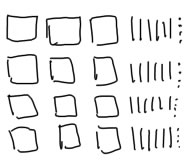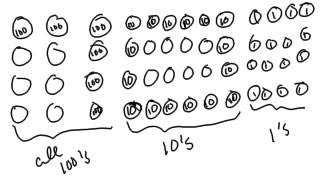
1. Sketch what 364x4 would look like if done with base 10 blocks.
A sketch will have less detail than the pictures I use for making the videos, so it will probably look something like this:

2. Sketch what 364x4 would look like if done with a non-proportional material such as the Montessori stamp game or those shown in Primary Mathematics 3A.
(This actually takes longer to draw and is larger to draw, though it is smaller (shorter??) with the actual materials)

3. Write out 364x4 using the expanded algorithm

4. Write out 364x4 using the standard algorithm

5. Why might one want to use a non-proportional material when teaching multi-digit multiplication?
Because proportional materials take up such a large amount of space in a large multiplication problem. You can do problems with larger numbers if your materials are smaller (non-proportional)
6. How can you make practice assignments in multiplication more effective for students who may struggle when learning math?
You can spread out the practice so that they are not doing too much at once (no burn-out), but they do some regularly every day for an extended period of time, so it gets put into long term memory.
7. What should you teach before teaching how to solve problems like 36x7 or 325x4? (What is the first step for teaching multi-digit multiplication?)
First teach multiplication of a 1-digit number by multiples of 10, like 20 or 60, and multiples of 100 like 300 or 900.
8. Why might a teacher want to teach the expanded algorithm before the standard algorithm?
So that children can see each of the place value properties separately and understand better how they are put together to get the final amount.